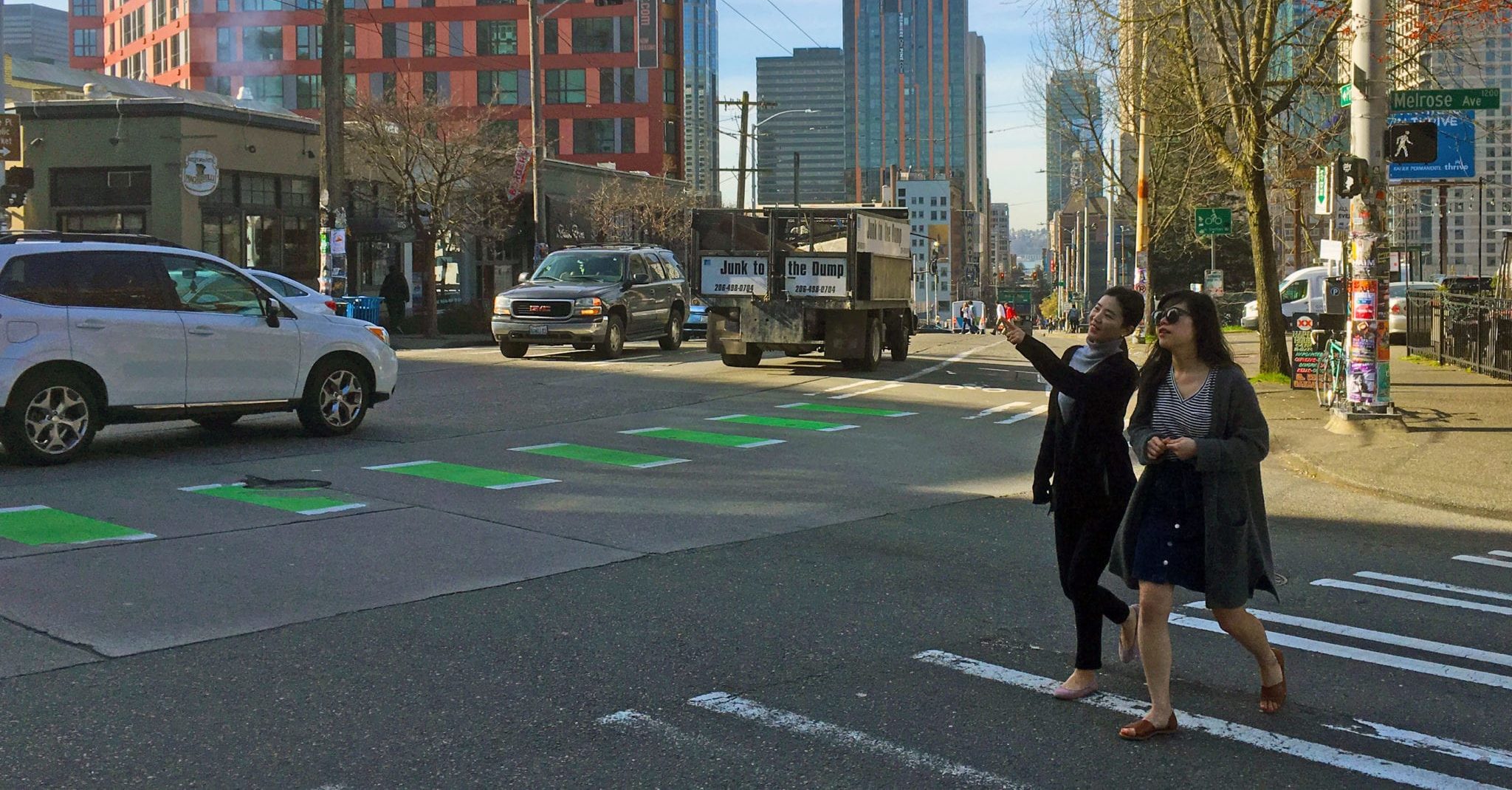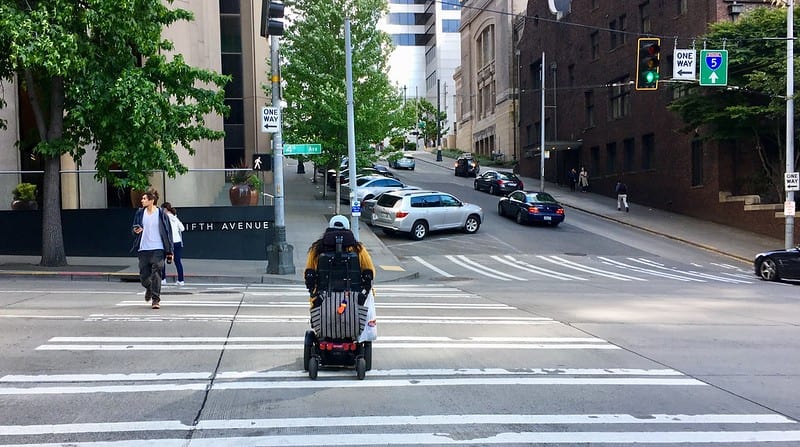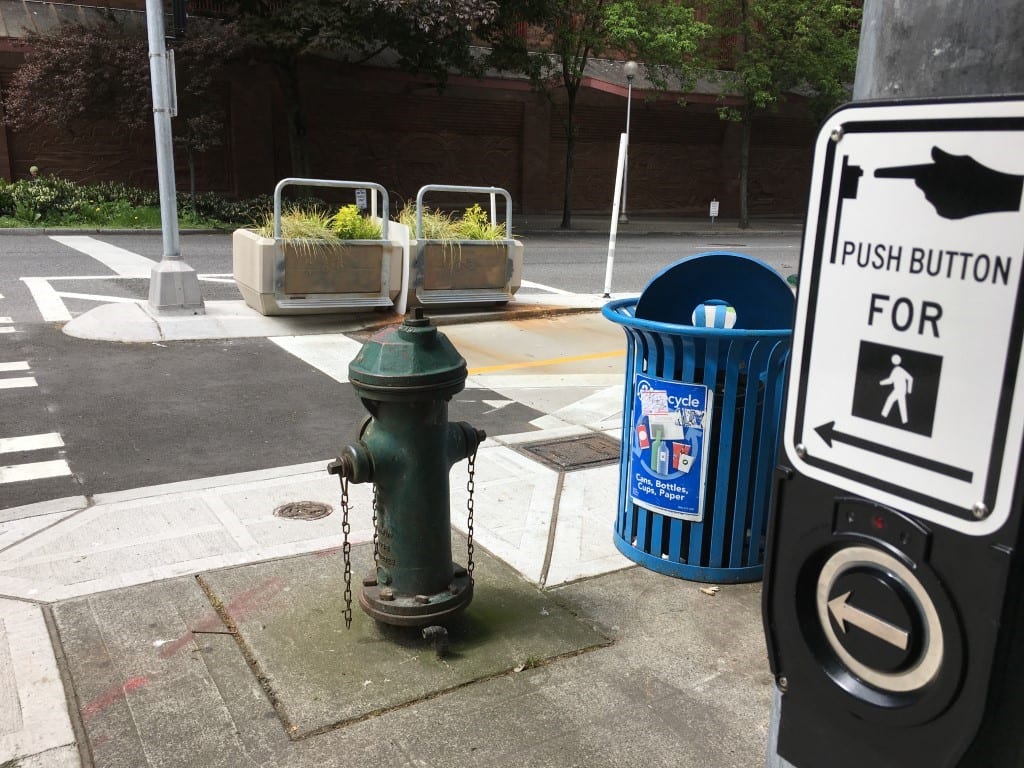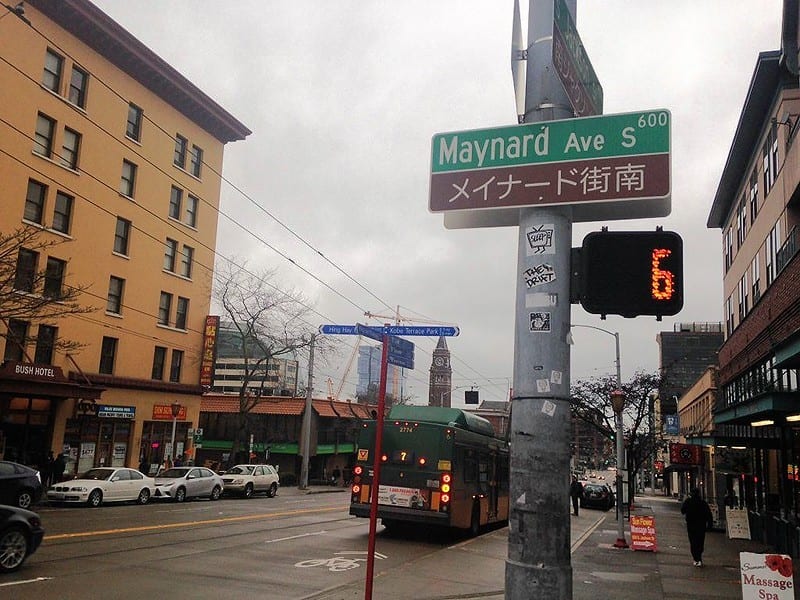 We continue to make our traffic signals work better for people walking and rolling, balancing the needs of people using all modes of transportation so everyone can travel safely. Photo credit SDOT Flickr
We continue to make our traffic signals work better for people walking and rolling, balancing the needs of people using all modes of transportation so everyone can travel safely. Photo credit SDOT Flickr Our newest pedestrian-first traffic signal policy update will:
- Give people more time to cross the street safely.
- Reduce pedestrian wait times at signals.
- Create more automatic walk signals so people don’t have to press a button.
- Build on other recent pedestrian-first policies and projects.
For many decades, Seattle’s transportation system, like most across the country, was designed to prioritize cars and personal vehicles.
As our city grows and we strive to become an equitable community, we now understand that the success of a transportation system is not determined by the ability to accommodate the most personal vehicles on our streets. Instead, success is determined by creating a city with safe, affordable, accessible, and dependable transportation options for people of all ages and abilities. This includes people walking, rolling, biking, riding transit, and driving freight vehicles, in addition to those driving personal vehicles.
Over the last few years, we’ve continued to make improvements to our traffic signals and crosswalks to help achieve our goal of becoming America’s most walkable city. We’ve installed pedestrian-first safety upgrades at more than 300 walk signals and have reprogrammed many intersections to automatically show a walk signal every time cars get a green light.
Building on this progress, we’ve been working on codifying and updating our traffic signal policy, with guidance from the Policy and Operations Advisory Group.
The Policy and Operations Advisory Group (POAG) convened in June 2020. For the pilot year, the POAG includes representatives from the Transportation Equity Workgroup, a Business Improvement Association, the Planning Commission, and the Pedestrian, Bike, Transit, and Freight Advisory Boards.
This policy will guide our approach to operating 1100 traffic signals in the city.
Our goals are to continue to make our traffic signals work better for people walking and rolling, balance the needs of people using all modes of transportation so everyone can travel safely, and help achieve Seattle’s long-term Vision Zero initiative to end traffic deaths and serious injuries on city streets by 2030.
My elderly mom uses a walker to get around, and I’ve seen how stressful it is for her to cross the street in time. This signal policy update is centered around prioritizing the safety of vulnerable people like her, and makes the transportation system work better for everyone. No matter whether you ride a bike, take the bus, drive a car, or deliver goods in a truck; we are all pedestrians when we leave our vehicles and we will all benefit from safety features like automatic pedestrian-first walk signals and a little more time to cross the street.
Adiam Emery, SDOT Director of Transportation Operations
Our traffic signal policy is centered on safety and accessibility for our most vulnerable travelers: people walking and rolling. Our intent is to save lives and prevent serious injuries by making changes that let people walk first and provide them longer crossing times. Automatic walk signals and shorter wait times will provide predictability and mobility for people walking and rolling.
Dongho Chang, SDOT City Traffic Engineer

More time to cross the street will better meet the needs of our most vulnerable travelers.
The traffic signal policy update will include guidelines to give people more time to cross the street and make our crosswalks safer for people of all ages and abilities.
We’ll use a new formula to calculate how long red countdown timers are displayed based on the length of the crosswalk. The formula goes beyond minimum federal requirements and follows recommendations from advocates for people with disabilities.
Today, people need to walk at least 3.5 feet per second to get across many crosswalks in the time allowed. From now on, we’ll allow enough time for people walking at a slower pace to get across (crosswalks will be programmed to be accessible for people walking 2.5 – 3.0 feet per second, depending on the exact location).
We’re making this change to ensure that our most vulnerable travelers – people with disabilities, children, and our elderly neighbors – can cross the street safely and comfortably while we continue to manage the multiple needs on our transportation system in a rapidly growing city.
We’re balancing the needs of everyone to prioritize safety and minimize delays.
This new policy will mean small, but meaningful, changes to the traffic signal patterns, which shouldn’t lead to noticeable delays.
To help make sure that we hit the right balance, our new traffic signal policy sets target and maximum cycle length times depending on the Street Type Designation. (The traffic signal cycle length is the time it takes to complete one entire sequence of all movements at an intersection.) In many cases, the shortest cycle length possible will be provided and only exceeded if other factors require a longer cycle length.
Data shows that long pedestrian wait times can lead to people crossing when they do not have the walk signal. This update helps minimize the pedestrian wait times and ensures the policy is implemented consistently across the city.

Prioritizing pedestrian access and mobility by creating automatic walk signals at more intersections.
In spring 2020, we began reprogramming many lights on timed cycles to automatically show a walk signal every time cars get a green light. Seattle now has nearly 480 intersections with walk signals which appear automatically, whether or not someone presses the walk button.
This update makes it even easier for people walking and rolling to travel.
Thanks to feedback from the Policy and Operations Advisory Group, automatic walk signals will now be our standard practice in more places than we originally proposed. Our new policy will make about two-thirds of all Seattle walk signals automatic, including every timed light in all Urban Villages (the parts of town with the most stores, restaurants, businesses, and other destinations for people to walk to).
In other parts of the city, or for signals that are not on a timer, we will evaluate each and create an automatic walk signal if specific thresholds are met, like the amount of people crossing or if nearby destinations serve a high number of vulnerable users.
Many push buttons still perform a critical function even at intersections with automatic walk signals – and locations with a push button that are upgraded to an automatic walk signal will not see the buttons removed. In fact, we have been investing a minimum of $500,000 each year to build accessible pedestrian signals which vibrate and make a noise to let people with limited vision or hearing know when it is safe to cross the street. We have built accessible pedestrian signals in 100 locations since 2018, and about 22% of the traffic signals in Seattle now have an accessible push button. But we recognize that there is still a lot of work to do and plan to continue making this investment to bring this important accessibility upgrade to more locations each year.

These policy updates build on other recent pedestrian-first policies and projects.
In 2019, we adopted a policy to re-program traffic signals to give people a few seconds head start to begin walking across the street before cars get the green light. This makes people in the crosswalk much more visible to drivers and drastically reduces the risk of being hit by a person driving a car.
We’ve added these pedestrian-first walk signals (also called “leading pedestrian intervals”) almost every time our engineers work on a traffic signal. Today, we have installed this safety upgrade in 316 traffic signals citywide (over 30% of all traffic signals). That’s more than double our original goal of 150 locations we set in June 2019, and even above a revised goal of 250 locations that we set at the end of 2019.
These traffic signals are working as expected and saving lives. We analyzed traffic data in the crosswalks where pedestrian-first intersections have been in place for at least a year and have seen a nearly 50% reduction in the number of people hit by cars while crossing the street. Serious injuries and fatalities in these locations fell by 33%.
Look for these changes in your favorite Seattle neighborhoods soon.
Individually evaluating and reprogramming traffic signals takes time, especially in places where the new timing would affect other nearby intersections. We’re excited about this continued effort to make crossing the street safer for people of all ages and abilities, and we look forward to hearing your feedback as we start experiencing these changes across the city.